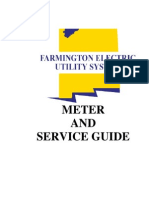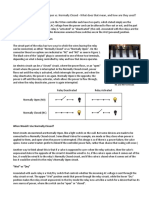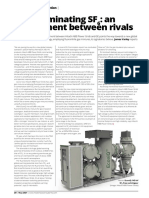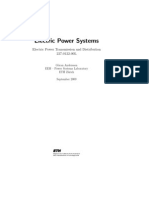Lecture 13 Distribution ProtectionDistribution Protection
Uploaded by
Afrizal RiandyLecture 13 Distribution ProtectionDistribution Protection
Uploaded by
Afrizal Riandy1
Lecture 13: Distribution
Protection
Reclosers
ELCT 751 DistributionProtection 1
Reclosers
Sectionalizers
Coordination
Secondary Network Systems
Reclosers
Automatic circuit reclosers are
common on overhead utility
distribution systems
ELCT 751 DistributionProtection 2
distribution systems
Overcurrent protection device
including the switchgear and the
protective relay logic
Reclosers
Types of reclosers
conventional oil recloser has
switchgear and relay logic in
ELCT 751 DistributionProtection 3
switchgear and relay logic in
same package
electronic reclosers may be
packaged for use with separate
control and relay logic package
Reclosers
Recloser trips on fault and
recloses in a sequence of
operations
T i l t f t (
ELCT 751 DistributionProtection 4
Typical sequence: two fast (or
instantaneous) operations then
two delayed operations
Other sequences may be used,
such as one fast, two delayed
Reclosers
Recloser trips on fault and
recloses in a sequence of
operations
ELCT 751 DistributionProtection 5
Reclosing may be blocked for
downstream hot line work
Recloser locks out after sequence
is complete
Recloser Sequence: permanent
fault
CURRENT
FAST OPERATIONS
(CONTACTS ARE CLOSED)
DELAYED OPERATIONS
(CONTACTS ARE CLOSED)
ELCT 751 DistributionProtection 6
TIME
FAULT INITIATED
RECLOSING INTERVALS
(CONTACTS ARE OPEN)
RECLOSER LOCKS
OPEN (LOCKOUT)
2
Recloser Technology
Available in single-phase or three-
phase packages
pole mounting for line sectionalizing
station mounting instead of line
ELCT 751 DistributionProtection 7
station mounting instead of line
circuit breaker
Three-phase devices may use
single-pole tripping with three-pole
lockout or three-pole tripping with
three-pole lockout
Recloser Technology
Interrupting medium may be oil,
vacuum, or compressed gas
Controls can be either hydraulic
with series trip coil or electronic
ELCT 751 DistributionProtection 8
with series trip coil or electronic
with shunt trip coil
Hydraulic controls use oil pumped
through an orifice to perform timing
Electronic controls use programmable
electronics
Recloser Technology
Insulation may be oil, air,
compressed gas, or solid dielectric
Old technology example: oil
insulation, oil interrupting medium,
ELCT 751 DistributionProtection 9
, p g ,
hydraulic (oil) timing
New technology example: solid
dielectric insulation, vacuum
interrupter, programmable electronic
timing, data logging (etc.)
Reclosers
ELCT 751 DistributionProtection 10
Hydraulic Recloser
Usually oil interrupting medium,
oil insulation, series trip coil
ELCT 751 DistributionProtection 11
Series trip coil usually has
minimum trip setting of 2 times
coil continuous current rating
Hydraulic Recloser
Example: 200 A frame size
recloser could have series trip coil
rated at 140 A (continuous)
giving a minimumtrip current of
ELCT 751 DistributionProtection 12
giving a minimum trip current of
2 x 140 A = 280 A
Due to limitations of hydraulic
logic: Limited number of different
time-current curves available
3
Electronically Controlled
Recloser
Often a vacuum interrupting
medium
Usually a shunt trip coil fed
ELCT 751 DistributionProtection 13
Usually a shunt trip coil fed
from a bushing CT with
electronic timing
Minimum trip setting is not fixed
by coil
Electronically Controlled Recloser
Minimum trip setting is not
fixed by coil
Example: Recloser with 560 A
continuous current rating could
ELCT 751 DistributionProtection 14
continuous current rating could
be set for 100, 140, 200, 280,
400, 560, 800, or 1120 A trip
Greater variety of time-current
curves
Recloser Ratings
All reclosers have
voltage ratings (nominal RMS line
voltage)
ELCT 751 DistributionProtection 15
interrupting ratings (RMS
symmetrical short-circuit current)
some method of changing trip
setting
Recloser Application
Primary advantage of recloser is
realized when most faults are
temporary
Overhead MV lines usually experience
ELCT 751 DistributionProtection 16
Overhead MV lines usually experience
many temporary faults
Underground MV lines usually
experience relatively fewer temporary
faults
Recloser Application
Recloser must coordinate with
other overcurrent protection,
upstreamand downstream
ELCT 751 DistributionProtection 17
upstream and downstream
Details of coordination covered
later
Recloser Application
Idea of coordination:
Recloser is to clear all temporary
faults downstream of recloser
ELCT 751 DistributionProtection 18
without damage to downstream
fuses
coordinating with downstream
reclosers and sectionalizers
4
Recloser Application
Idea of coordination:
Recloser is to clear all temporary
faults downstream of recloser
Permanent faults downstreamof
ELCT 751 DistributionProtection 19
Permanent faults downstream of
recloser are cleared by
downstream device
if it sees fault
before recloser locks out
Recloser Application
Electronic controls give much
greater choice of time-current
curves than hydraulic
Example below shows recloser curves
ELCT 751 DistributionProtection 20
Example below shows recloser curves
matching IEC time-overcurrent relay
curves for circuit breakers
May allow complete freedom to tailor
curves for specific application
1
10
100
IEC TOC Curves
T
im
e
[
s
e
c
]
ELCT 751 DistributionProtection 21
1 10 100
0.1
Inverse
Very Inverse
Extremely Inverse
Current [per unit of trip]
Sectionalizers
Automatic circuit sectionalizer is
similar to a recloser, but:
ELCT 751 DistributionProtection 22
sectionalizer does not interrupt
fault current
sectionalizer does not have time-
current curve
Sectionalizers
Automatic circuit sectionalizer is
similar to a recloser, but:
sectionalizer counts the number
f i i i i ( d
ELCT 751 DistributionProtection 23
of circuit interruptions (presumed
to be due to upstream recloser or
station breaker) and locks out
after preset number (while
upstream device is open)
Sectionalizer Operation
Sectionalizer operation
sectionalizer senses overcurrent
and arms to count
h t f ll b l th
ELCT 751 DistributionProtection 24
when current falls below the
sectionalizer setting, it counts
when count sequence is
complete, sectionalizer locks
open
5
Sectionalizers
Replace fuse on close-to-station tap
fuse coordination is difficult due to
large available short-circuit current
Replace second recloser where
ELCT 751 DistributionProtection 25
epace seco d ecose e e
recloser-to-recloser coordination is
difficult
both reclosers may operate
simultaneously if close together
Sectionalizer Application
Set sectionalizer count one
fewer than upstream recloser
ELCT 751 DistributionProtection 26
Example: Four-shot recloser
followed by three-shot
sectionalizer
Sectionalizer Application
Set sectionalizer count one
fewer than upstream recloser
Use three-phase (three-pole
ELCT 751 DistributionProtection 27
p ( p
trip) recloser with three-phase
sectionalizer
Otherwise, sectionalizer could
attempt to interrupt fault current
causing failure
Sectionalizer Problems
Recloser-sectionalizer-recloser
combination not recommended
unless studied carefully
Recloser sectionalizer fuse
ELCT 751 DistributionProtection 28
Recloser-sectionalizer-fuse
combination may need study
Sectionalizer can count downstream
device operations
Considered in more detail later.
Sectionalizer Technology
Hydraulic controls
Series coil senses fault current and
arms counting mechanism
After preset count sequence, contacts
ELCT 751 DistributionProtection 29
opened
Electronic controls
Shunt coil feeding programmable
electronic controls
Set actuation level, memory time
Sectionalizer Settings
Set minimum actuation current
at 80% of minimum trip current
of upstreamrecloser
ELCT 751 DistributionProtection 30
of upstream recloser
Hydraulic controls: use same
series coil rating for both units
Electronic controls: must be set
for proper value
6
Sectionalizer Settings
Electronic recloser feeding
hydraulic sectionalizer: Minimum
actuating current of sectionalizer
ELCT 751 DistributionProtection 31
actuating current of sectionalizer
= 1.6 X series coil rating.
Compare to recloser minimum
trip stetting.
Sectionalizer
ELCT 751 DistributionProtection 32
Coordination
Proper coordination ensures
that minimum equipment is
taken out of service to clear the
fault
ELCT 751 DistributionProtection 33
Coordination minimizes number
of customers out of service
Coordination speeds the
troubleshooting, so minimizes the
duration of the outage
Typical System
S
Y
S
T
E
M
FEEDER #1
FEEDER #2
ELCT 751 DistributionProtection 34
H
V
FUSE SECTIONALIZER RECLOSER
Fuse-to-fuse coordination
The protected fuse is upstream;
the protecting fuse is
downstream
Fuse A is the protecting fuse;
ELCT 751 DistributionProtection 35
Fuse A is the protecting fuse;
fuse B is the protected fuse
Protecting fuse A must clear the
fault before protected fuse B is
damaged
Fuse-to-fuse coordination
Protecting fuse A must clear the
fault before protected fuse B is
damaged
PROTECTED
ELCT 751 DistributionProtection 36
PROTECTED
FUSE (B)
PROTECTING
FUSE (A)
FEEDER
7
Time-current curves for both
fuses
Proper coordination requires
maximum clearing time of
protecting fuse less than minimum
ELCT 751 DistributionProtection 37
p g
melt time of protected fuse
To check coordination, plot both
time-current curves on same graph
TIME [SEC]
FUSE B (PROTECTED)
FUSE A (PROTECTING)
MINIMUM MELT CURVE
ELCT 751 DistributionProtection 38
CURRENT [A]
MINIMUM MELT CURVE
SHIFTED TO 75% TIME
MAX. CLEARING TIME
Fuse Preheating
Since fuse operation is thermal, fuse
preheating should be considered:
Load currents and high ambient
temperatures
ELCT 751 DistributionProtection 39
p
Conservative rule of thumb to
maintain coordination:
Shift minimum melt curve of protected
fuse to 75% time (shown on previous
slide)
1
10
100
1
10
3
T
im
e
[
s
e
c
]
ELCT 751 DistributionProtection 40
10 100 1
10
3
1
10
4
0.01
0.1
10K tot clear
10K min melt
15K tot clear
15K min melt
Current [A]
Recloser-Fuse Coordination
Recloser feeding a fuse:
Fast operations of recloser should
protect entire downstream line
( f ibl ) f
ELCT 751 DistributionProtection 41
(as far as possible) from
temporary faults (fuse saving)
Fuse link should not be damaged
by fast operation
Recloser-Fuse Coordination
Recloser feeding a fuse:
Fuse saving
Fuse link should not be damaged
ELCT 751 DistributionProtection 42
by fast operation
Permanent fault should cause
fuse to blow on first delayed
operation
8
Recloser operation - fuse link heating
V pu
Ipu
1
0
0
If
t
t
OPEN OPEN OPEN LOCKS OUT
ELCT 751 DistributionProtection 43
CLOSED CLOSED CLOSED
FUSE SHOULD BLOW DURING ONE
OF THESE DELAYED OPERATIONS
FUSE LINK
TEMPERATURE
FUSE SHOULD NOT
BE DAMAGED HERE
Fuse link heating
Fuse link heats during the
recloser closed periods and
cools during the open periods
ELCT 751 DistributionProtection 44
cools during the open periods
If reclosing interval is longer than
link thermal time constant, link
may cool completely
Fuse link heating
If reclosing interval is shorter
than link thermal time constant,
link may not cool at all
ELCT 751 DistributionProtection 45
y
If detailed calculations are not
done, assume no cooling to be
conservative
Recloser-fuse coordination
Assume no cooling of fuse link
Assume recloser sequence is
2 2
ELCT 751 DistributionProtection 46
2A2B
two fast (A curve) followed by
two delayed (B curve) operations
Recloser-fuse coordination
Plot 2 times recloser A curve to
compare with fuse minimum
melt curve
ELCT 751 DistributionProtection 47
melt curve
Plot 2A+B to compare with fuse
maximum clearing time
Fuse and recloser time-current
curves showing coordination
TI ME
FUSE MAX CLEARI NG TI ME
FUSE MIN
MELT TI ME
ELCT 751 DistributionProtection 48
CURRENT
A
2 X A
2 X A + B
RECLOSER CURVES
COORDINATION RANGE
9
Recloser fuse coordination
Less conservative calculations can be
done
compare 1.75 times A curve to fuse link
min melt time
ELCT 751 DistributionProtection 49
min melt time
compare B to fuse link max clearing time
Calculate the actual cooling based on
thermal time constant of fuse link in
cutout and ambient temperature
Fuse-Recloser Coordination
Reclosers downstream of fuses
are not common
N t d d d t
ELCT 751 DistributionProtection 50
Not recommended and not
considered here
Fuse-Recloser Coordination
Exception: power fuse
protecting substation
transformer on HV side
Must coordinate with MV circuit
ELCT 751 DistributionProtection 51
Must coordinate with MV circuit
breaker and any downstream
reclosers
Considered in section on
substation protection
Recloser-Recloser Coordination
Use time-current curves to
coordinate
Hydraulically controlled units need
about 12 cycles of margin between
dj t it t di t
ELCT 751 DistributionProtection 52
adjacent unit to coordinate
If margin is 2-12 cycles the units
might operate simultaneously
If margin is less than 2 cycles, the
units will operate simultaneously
Recloser-Recloser Coordination
Electronically controlled units
are simply coordinated with
manufacturers time-current
curves:
ELCT 751 DistributionProtection 53
curves:
Maximum clearing time of
downstream (protecting) recloser
less than minimum response time
of upstream (protected) recloser
Reclosing Interval
Time from trip to reclose
Fixed by design of hydraulic
units: 1-2 sec
ELCT 751 DistributionProtection 54
units: 1 2 sec
Programmable in electronic units:
2 sec for example
10
Reclosing Interval
Programmable in electronic units
set from instantaneous to 60 sec
instantaneous is usually too fast to
allowtemporaryfaultstoclear
ELCT 751 DistributionProtection 55
allow temporary faults to clear
2 seconds is a common setting
longer settings, e.g. 5 sec, may aid
coordination with source-side
circuit breakers or fuses
Coordination of recloser with
station circuit breaker
Station circuit breaker may be
used, with overcurrent relay
ELCT 751 DistributionProtection 56
logic
Overcurrent relays tend to
integrate recloser times
Coordination of recloser with
station circuit breaker
Quick check is to compare relay
time-current curve to a
cumulative recloser time current
ELCT 751 DistributionProtection 57
cumulative recloser time current
curve (e.g., 2A+2B in time)
If check shows miscoordination
possible, perform detailed
calculation
Example relay-recloser
coordination
Electromechanical time overcurrent
relay: 0.60 second trip delay and
30 sec reset time
ELCT 751 DistributionProtection 58
Hydraulic recloser on 2A2B
sequence
At fault current: A curve gives
0.035 sec and B curve gives 0.20
sec.
Example relay-recloser
coordination
Disk travel:
Each A clearing: relay disk
0 035/0 60 or 5 8%
ELCT 751 DistributionProtection 59
0.035/0.60 or 5.8%
Each B clearing: relay disk
0.20/0.60 or 33.3%
Each 2 sec open time: relay disk
2/30 or -6.7%
Example (Continued)
Relay completely resets after
each fast (A curve) operation
Calculate total net travel until
lockout:
ELCT 751 DistributionProtection 60
33.3% - 6.7% + 33.3% = 60% <
100%
Relay contacts do not close
Coordination is correct
11
Example (Continued)
Repeat for 1 sec reclosing
interval
Now relay does not completely
reset after fast operations
ELCT 751 DistributionProtection 61
reset after fast operations
Net total relay travel:
5.8-3.3+5.8-3.3+33.3-3.3+33.3 =
68.3% <100%
Coordination is still achieved.
Electronic Devices
Electronically controlled reclosers
have more choices of time-current
curves and reclosing intervals
Electronic overcurrent relays have
ELCT 751 DistributionProtection 62
Electronic overcurrent relays have
more choices of time-current curves
and no disk to reset
Consult relay manufacturers data to
determine reset time (may be a setting)
Sectionalizer Coordination
Does not use time-current curves
Sectionalizer will coordinate with
upstream recloser or circuit breaker
if it is set for fewer counts than the
ELCT 751 DistributionProtection 63
total number of upstream device
operations
Example: four shot upstream
recloser coordinates with a three-
shot downstream sectionalizer
Sectionalizer Application
Two sectionalizers may be used
in series if the downstream
device is set to one fewer count
ELCT 751 DistributionProtection 64
device is set to one fewer count
than the upstream device
Recloser-sectionalizer-fuse
coordination:
Sectionalizer Application
Recloser-sectionalizer-fuse
coordination:
sectionalizer counts downstream
ELCT 751 DistributionProtection 65
fuse blowing
2A2B recloser: fuse blows during
first delayed operation,
sectionalizer arms for final count,
then locks out when fuse blows
Sectionalizer Application
Use 1A3B recloser for 3 shot
sectionalizer with downstream
fuse:
ELCT 751 DistributionProtection 66
fuse:
Fuse clears on second recloser
count, sectionalizer does not lock
out when fuse blows
12
Sectionalizer Application
Recloser-sectionalizer-recloser
is tricky:
Sectionalizer may count either
ELCT 751 DistributionProtection 67
Sectionalizer may count either
recloser
Can work with sectionalizer
voltage restraint to prevent
counting downstream operations
Effect of Distribution
Automation / Remote Control
Distribution automation and
remote control of switches is
ELCT 751 DistributionProtection 68
mostly outside of our scope
Except as it interacts with
overcurrent protection system
Effect of Distribution
Automation / Remote Control
Consider a typical radial feeder
arrangement with normally open
ELCT 751 DistributionProtection 69
g y p
tie switches and normally closed
sectionalizing switches
Look at feeder reconfiguration
Feeder 1
NO
Tie
CB1 S1
T12
Load break switch
ELCT 751 DistributionProtection 70
Feeder 2
Normal Operation
CB2 S2
Feeder 1
NO
Tie
CB1 S1
T12
ELCT 751 DistributionProtection 71
Feeder 2
Fault at X cleared by station breaker
CB1.
CB2 S2
NO
Tie
CB1 S1
T12
ELCT 751 DistributionProtection 72
Feeder 2
Operator opens S1 then closes T12
CB2 S2
13
Recloser Loop Scheme
Consider a recloser loop scheme:
Feeder use a sectionalizing recloser
Adjacent feeder backs up to normally
open tie recloser
l i l i b k
ELCT 751 DistributionProtection 73
Fault trips recloser or station breaker
If sectionalizing recloser loses voltage,
it trips after 60 second delay
If tie recloser loses voltage, it closes
after 70 second delay
Feeder 1
NO
Tie
CB1 R1
T12
Recloser
ELCT 751 DistributionProtection 74
Feeder 2
Normal Operation
CB2 R2
Feeder 1
NO
Tie
CB2
CB1 R1
R2
T12
ELCT 751 DistributionProtection 75
Feeder 2
Fault at X cleared by station breaker
CB1. R1 and T12 lose voltage.
C
NO
Tie
CB2
CB1 R1
R2
T12
ELCT 751 DistributionProtection 76
Feeder 2
60 seconds after R1 loses voltage, it
automatically opens, then after 10
more seconds, T12 closes.
C
Network Systems
Full network distribution systems
are rare, except for secondary
networks (downtown areas of
cities) and spot networks (large
ELCT 751 DistributionProtection 77
cities) and spot networks (large
buildings)
MV feeder circuits are radially
connected to network transformers
Transformer secondaries (LV)
networked
HV Bus
Substation
MV Feeders
Network Transformers
Network Protectors
ELCT 751 DistributionProtection 78
Loads
LV Network
SECONDARY NETWORK
14
Network Transformers
MV Feeders
HV Bus
Substation
ELCT 751 DistributionProtection 79
SPOT NETWORK
Network Protectors and Fuses
LV Network
Loads
Network Systems
The secondary and spot network
systems are quite flexible in
operation
If one transformer is out of service,
ELCT 751 DistributionProtection 80
,
the remaining units can supply the
load
If a fault occurs on a primary
feeder, the transformer will tend to
feed it
Network Protector
Network protector will disconnect
the transformer if it back-feeds the
MV system
Network protector will prevent
ELCT 751 DistributionProtection 81
p p
transformer from being
reconnected unless power will flow
in proper direction
Fuses are often used on network
systems too
Low-Voltage System
Overcurrent Protection
Devices used are fuses and air
circuit breakers, including:
Molded-case circuit breakers
I l t d i it b k
ELCT 751 DistributionProtection 82
Insulated-case circuit breakers
LV power circuit breakers
Time-current curves are used for
coordination in the same way as
already described.
Insulated-case circuit breakers
ELCT 751 DistributionProtection 83
Typical Low-Voltage
Circuit Breaker Time-
Current (Electronic Trip)
T
i
m
e
Long time pickup
Long time dela
ELCT 751 DistributionProtection 84
Current
Long time delay
Short time pickup
Short time delay
Instantaneous
15
T
i
m
e
Long time pickup
ELCT 751 DistributionProtection 85
Current
T
i
m
e
Long time delay
ELCT 751 DistributionProtection 86
Current
Short time delay
similar to long
time delay
T
i
m
e
Sh k
ELCT 751 DistributionProtection 87
Current
Short time pickup
T
i
m
e
ELCT 751 DistributionProtection 88
Current
Instantaneous
SHORT-TIME
PICKUP
SHORT-TIME
DELAY
LONG-TIME
PI CKUP LONG-TIME
PICKUP
LONG-TIME
DELAY
LONG-TIME
TIME
ELCT 751 DistributionProtection 89
INSTANTANEOUS
INSTANTANEOUS
SHORT-TIME
PICKUP
LONG TIME
DELAY
(SHORT-TIME
DELAY SIMILAR)
CURRENT
Coordination
As before, coordination is done
with time-current curves
In all overcurrent protection the
downstream device should trip
ELCT 751 DistributionProtection 90
p
and clear the fault
Before the fastest upstream device
begins operation
Before system damage becomes
excessive
16
Coordination
As before, coordination is
done with time-current curves
Compromise is sometimes
ELCT 751 DistributionProtection 91
Compromise is sometimes
required: Main purpose is to
protect system from short-
circuits
Where to go for more information
Application and Coordination of
Reclosers, Sectionalizers, and
Fuses, IEEE Tutorial 80EHO157-
ELCT 751 DistributionProtection 92
8-PWR
Distribution System Protection
Manual, Cooper Power Systems
Where to go for more information
Manufacturers web sites:
www.abb.com,
www.cooperpower.com,
wwwch cutler hammer com
ELCT 751 DistributionProtection 93
www.ch.cutler-hammer.com,
www.ge.com,
www.sandc.com,
www.siemenstd.com,
www.squared.com
You might also like
- Negative-Sequence Overcurrent Considerations For Induction Motor Loads100% (1)Negative-Sequence Overcurrent Considerations For Induction Motor Loads10 pages
- Automatic Star Delta Starter Project Thesis82% (11)Automatic Star Delta Starter Project Thesis37 pages
- Protection of Power Systems: 6. Reclosers and Fuses100% (1)Protection of Power Systems: 6. Reclosers and Fuses16 pages
- Basic Distribution Engg Utility System Operations PDFNo ratings yetBasic Distribution Engg Utility System Operations PDF67 pages
- Compliance To Philippine Distribution CodeNo ratings yetCompliance To Philippine Distribution Code3 pages
- Wefix Construction Services Incorporated: (Weekly Activity Report)No ratings yetWefix Construction Services Incorporated: (Weekly Activity Report)4 pages
- Energizing The Countryside, Electrifying The Future: National Electrification AdministrationNo ratings yetEnergizing The Countryside, Electrifying The Future: National Electrification Administration82 pages
- Single-Family Dwelling Unit Electrical System DesignNo ratings yetSingle-Family Dwelling Unit Electrical System Design19 pages
- Tripping of Air Circuit Breaker: Trip Indicators Test/Reset Button LCD DisplayNo ratings yetTripping of Air Circuit Breaker: Trip Indicators Test/Reset Button LCD Display5 pages
- SEL-487B-1 Bus Differential Relay: Busbar and Breaker Failure Protection, Automation, and Control SystemNo ratings yetSEL-487B-1 Bus Differential Relay: Busbar and Breaker Failure Protection, Automation, and Control System32 pages
- Off Grid Systems: Micro and Mini-Grids For Rural and Marginalised Communities100% (1)Off Grid Systems: Micro and Mini-Grids For Rural and Marginalised Communities20 pages
- Training Course Power System Protection: About DNVNo ratings yetTraining Course Power System Protection: About DNV2 pages
- Artificial Intelligence A Z Learn How To Build An AI 2100% (1)Artificial Intelligence A Z Learn How To Build An AI 233 pages
- Protection of Microgrid Through Coordinated Directional Over-Current RelaysNo ratings yetProtection of Microgrid Through Coordinated Directional Over-Current Relays6 pages
- Solutions For System Loss Reduction - R12 PDFNo ratings yetSolutions For System Loss Reduction - R12 PDF20 pages
- Summary of WECC Voltage Stability Assessment MethodologyNo ratings yetSummary of WECC Voltage Stability Assessment Methodology7 pages
- 2021 Version of Electrical Shopwork I For Electrical Engineering and Technology Students Isbn 9781685642792No ratings yet2021 Version of Electrical Shopwork I For Electrical Engineering and Technology Students Isbn 978168564279294 pages
- Power System Analysis - Bergen and Vittal2No ratings yetPower System Analysis - Bergen and Vittal22 pages
- Power Quality and The Philippine Grid CodeNo ratings yetPower Quality and The Philippine Grid Code15 pages
- Power Transmission Infrastructure: Philippine Setting: April 25, 2018 National Grid Corporation of The PhilippinesNo ratings yetPower Transmission Infrastructure: Philippine Setting: April 25, 2018 National Grid Corporation of The Philippines27 pages
- Adaptive Weed Detection and Removal Using Cutter and Pesticide Spraying AGBOTNo ratings yetAdaptive Weed Detection and Removal Using Cutter and Pesticide Spraying AGBOT8 pages
- 2020-10-22 Planning Guidline For MV Protection100% (1)2020-10-22 Planning Guidline For MV Protection62 pages
- PEG - 70 - KAP - 01 Smart Grids and The New Age of EnergyNo ratings yetPEG - 70 - KAP - 01 Smart Grids and The New Age of Energy0 pages
- Triton Relays Normally Open Vs Normally Closed PDFNo ratings yetTriton Relays Normally Open Vs Normally Closed PDF2 pages
- Learning Power Systems Beyond Class and Control Room100% (1)Learning Power Systems Beyond Class and Control Room50 pages
- Item - 4a. - Integrating - Inverter-Based - Resources - Into - Low - Short - Circuit - Strength - Systems - 2017-11-08-FINALNo ratings yetItem - 4a. - Integrating - Inverter-Based - Resources - Into - Low - Short - Circuit - Strength - Systems - 2017-11-08-FINAL47 pages
- 7SR11 and 7SR12 - Argus Complete Technical ManualNo ratings yet7SR11 and 7SR12 - Argus Complete Technical Manual398 pages
- Microgrid Protection Using Communication-Assisted Digital RelaysNo ratings yetMicrogrid Protection Using Communication-Assisted Digital Relays8 pages
- Communication and Control in Electric Power Systems: Applications of Parallel and Distributed ProcessingFrom EverandCommunication and Control in Electric Power Systems: Applications of Parallel and Distributed ProcessingNo ratings yet
- Generator Sizing: This Section Will Help Walk You Through That ProcessNo ratings yetGenerator Sizing: This Section Will Help Walk You Through That Process4 pages
- Lecture 1: Introduction To Power Distribution SystemsNo ratings yetLecture 1: Introduction To Power Distribution Systems23 pages
- Detection of Underground Cable Fault Using Arduino and GSMNo ratings yetDetection of Underground Cable Fault Using Arduino and GSM1 page
- Lab - 2 EEng 3112 Single Phase Transformer TestsNo ratings yetLab - 2 EEng 3112 Single Phase Transformer Tests5 pages
- ",YBIS MID DBBIGlO OF A DC TO DC RBBO - COMVERTBR FOR RAILROAD APPLICATIOMBNo ratings yet",YBIS MID DBBIGlO OF A DC TO DC RBBO - COMVERTBR FOR RAILROAD APPLICATIOMB6 pages
- JNTUH 3-2 R16 QP Power Systems Analysis May - 2019No ratings yetJNTUH 3-2 R16 QP Power Systems Analysis May - 20193 pages
- List of Upcoming Power Plants in Chhattisgarh100% (1)List of Upcoming Power Plants in Chhattisgarh3 pages
- 1-Regulations For Electrical Installations MEW-R1 (ENGLISH)No ratings yet1-Regulations For Electrical Installations MEW-R1 (ENGLISH)72 pages
- FINAL Cable - Schedule - KCL 16.03.2023 R1100% (1)FINAL Cable - Schedule - KCL 16.03.2023 R114 pages
- Siemens Allis SG 6018 Electronic Metering PackageNo ratings yetSiemens Allis SG 6018 Electronic Metering Package41 pages
- Lec-7 Bus Switching Schemes Double Main & Transfer (DMT) One and Half CB Schemes in EnglishNo ratings yetLec-7 Bus Switching Schemes Double Main & Transfer (DMT) One and Half CB Schemes in English6 pages
- Draft SPECIFICATION For Power Quality RestorerNo ratings yetDraft SPECIFICATION For Power Quality Restorer44 pages
- To Obtain The Performance of DC Series Motor by Load TestNo ratings yetTo Obtain The Performance of DC Series Motor by Load Test4 pages
- Negative-Sequence Overcurrent Considerations For Induction Motor LoadsNegative-Sequence Overcurrent Considerations For Induction Motor Loads
- Grid Converters for Photovoltaic and Wind Power SystemsFrom EverandGrid Converters for Photovoltaic and Wind Power Systems
- Protection of Power Systems: 6. Reclosers and FusesProtection of Power Systems: 6. Reclosers and Fuses
- Basic Distribution Engg Utility System Operations PDFBasic Distribution Engg Utility System Operations PDF
- Wefix Construction Services Incorporated: (Weekly Activity Report)Wefix Construction Services Incorporated: (Weekly Activity Report)
- Energizing The Countryside, Electrifying The Future: National Electrification AdministrationEnergizing The Countryside, Electrifying The Future: National Electrification Administration
- Single-Family Dwelling Unit Electrical System DesignSingle-Family Dwelling Unit Electrical System Design
- Tripping of Air Circuit Breaker: Trip Indicators Test/Reset Button LCD DisplayTripping of Air Circuit Breaker: Trip Indicators Test/Reset Button LCD Display
- SEL-487B-1 Bus Differential Relay: Busbar and Breaker Failure Protection, Automation, and Control SystemSEL-487B-1 Bus Differential Relay: Busbar and Breaker Failure Protection, Automation, and Control System
- Off Grid Systems: Micro and Mini-Grids For Rural and Marginalised CommunitiesOff Grid Systems: Micro and Mini-Grids For Rural and Marginalised Communities
- Training Course Power System Protection: About DNVTraining Course Power System Protection: About DNV
- Artificial Intelligence A Z Learn How To Build An AI 2Artificial Intelligence A Z Learn How To Build An AI 2
- Protection of Microgrid Through Coordinated Directional Over-Current RelaysProtection of Microgrid Through Coordinated Directional Over-Current Relays
- Summary of WECC Voltage Stability Assessment MethodologySummary of WECC Voltage Stability Assessment Methodology
- 2021 Version of Electrical Shopwork I For Electrical Engineering and Technology Students Isbn 97816856427922021 Version of Electrical Shopwork I For Electrical Engineering and Technology Students Isbn 9781685642792
- Power Transmission Infrastructure: Philippine Setting: April 25, 2018 National Grid Corporation of The PhilippinesPower Transmission Infrastructure: Philippine Setting: April 25, 2018 National Grid Corporation of The Philippines
- Adaptive Weed Detection and Removal Using Cutter and Pesticide Spraying AGBOTAdaptive Weed Detection and Removal Using Cutter and Pesticide Spraying AGBOT
- PEG - 70 - KAP - 01 Smart Grids and The New Age of EnergyPEG - 70 - KAP - 01 Smart Grids and The New Age of Energy
- Triton Relays Normally Open Vs Normally Closed PDFTriton Relays Normally Open Vs Normally Closed PDF
- Learning Power Systems Beyond Class and Control RoomLearning Power Systems Beyond Class and Control Room
- Item - 4a. - Integrating - Inverter-Based - Resources - Into - Low - Short - Circuit - Strength - Systems - 2017-11-08-FINALItem - 4a. - Integrating - Inverter-Based - Resources - Into - Low - Short - Circuit - Strength - Systems - 2017-11-08-FINAL
- Microgrid Protection Using Communication-Assisted Digital RelaysMicrogrid Protection Using Communication-Assisted Digital Relays
- Power System Wide-area Stability Analysis and ControlFrom EverandPower System Wide-area Stability Analysis and Control
- Communication and Control in Electric Power Systems: Applications of Parallel and Distributed ProcessingFrom EverandCommunication and Control in Electric Power Systems: Applications of Parallel and Distributed Processing
- Generator Sizing: This Section Will Help Walk You Through That ProcessGenerator Sizing: This Section Will Help Walk You Through That Process
- Lecture 1: Introduction To Power Distribution SystemsLecture 1: Introduction To Power Distribution Systems
- Detection of Underground Cable Fault Using Arduino and GSMDetection of Underground Cable Fault Using Arduino and GSM
- ",YBIS MID DBBIGlO OF A DC TO DC RBBO - COMVERTBR FOR RAILROAD APPLICATIOMB",YBIS MID DBBIGlO OF A DC TO DC RBBO - COMVERTBR FOR RAILROAD APPLICATIOMB
- JNTUH 3-2 R16 QP Power Systems Analysis May - 2019JNTUH 3-2 R16 QP Power Systems Analysis May - 2019
- 1-Regulations For Electrical Installations MEW-R1 (ENGLISH)1-Regulations For Electrical Installations MEW-R1 (ENGLISH)
- Lec-7 Bus Switching Schemes Double Main & Transfer (DMT) One and Half CB Schemes in EnglishLec-7 Bus Switching Schemes Double Main & Transfer (DMT) One and Half CB Schemes in English
- To Obtain The Performance of DC Series Motor by Load TestTo Obtain The Performance of DC Series Motor by Load Test

























































































